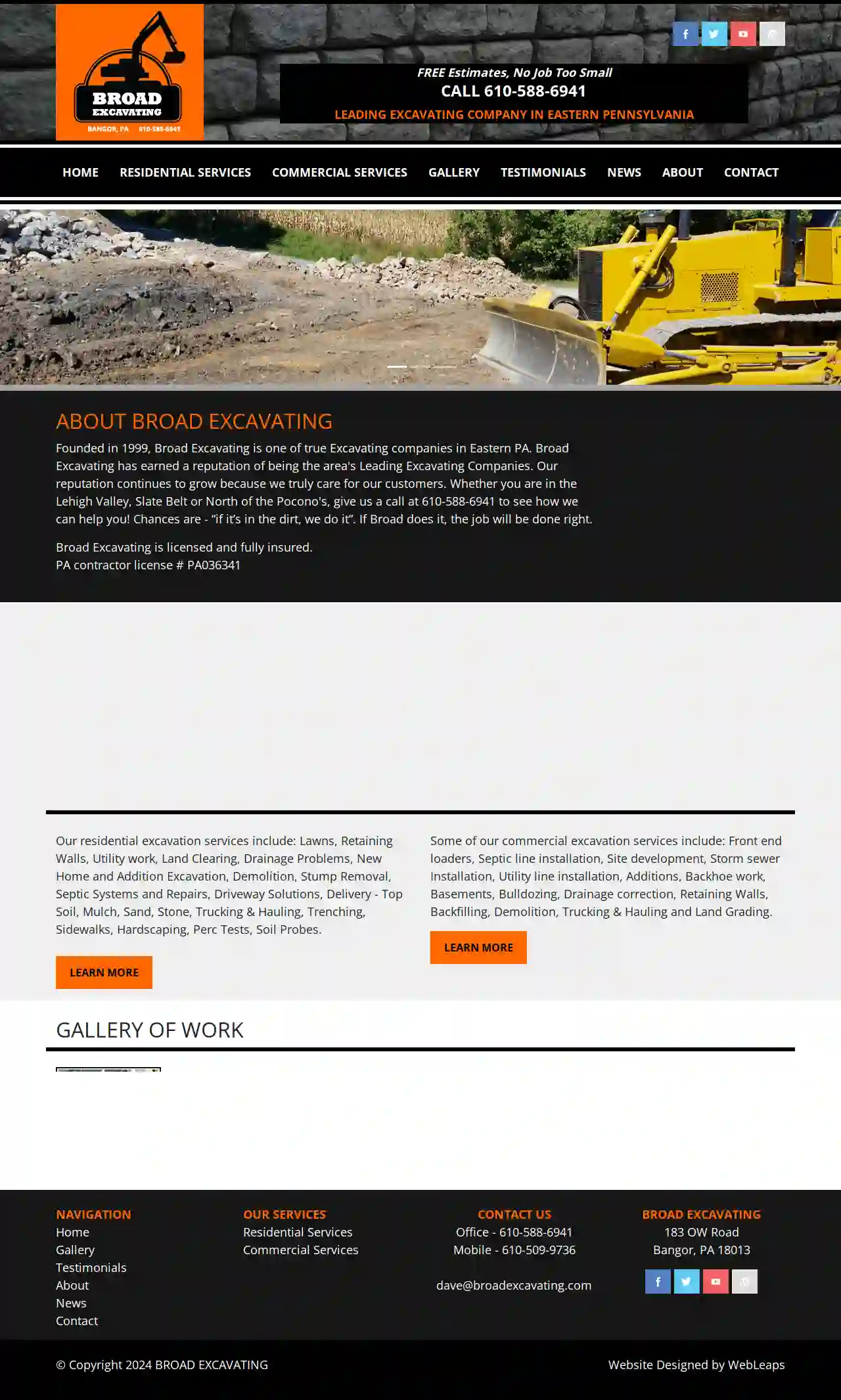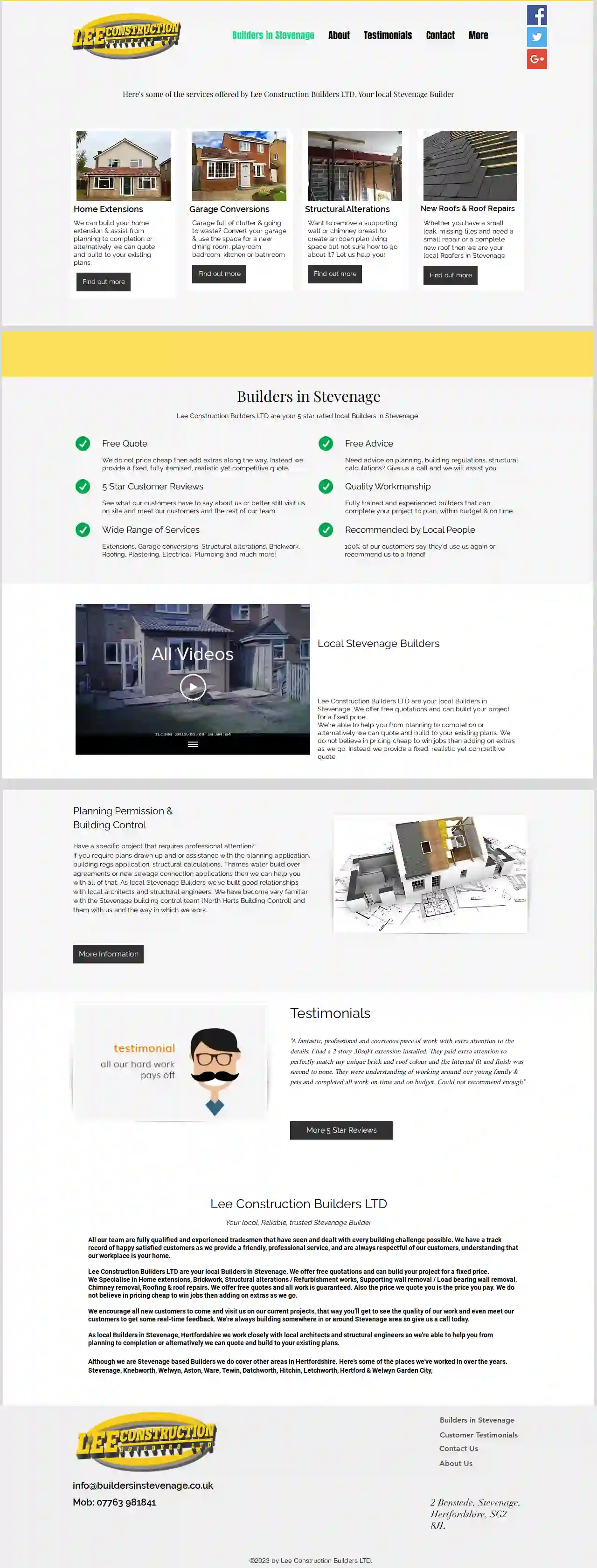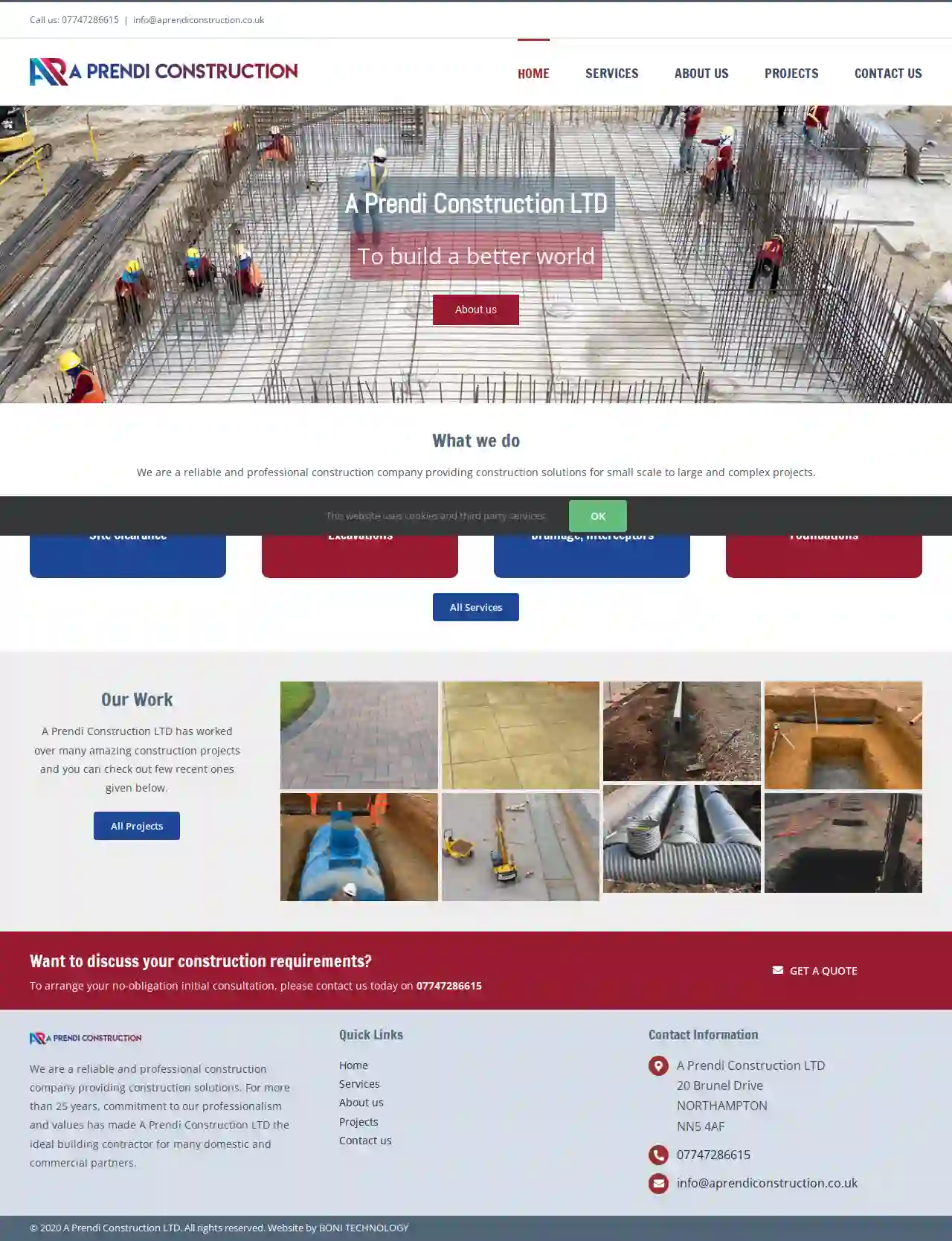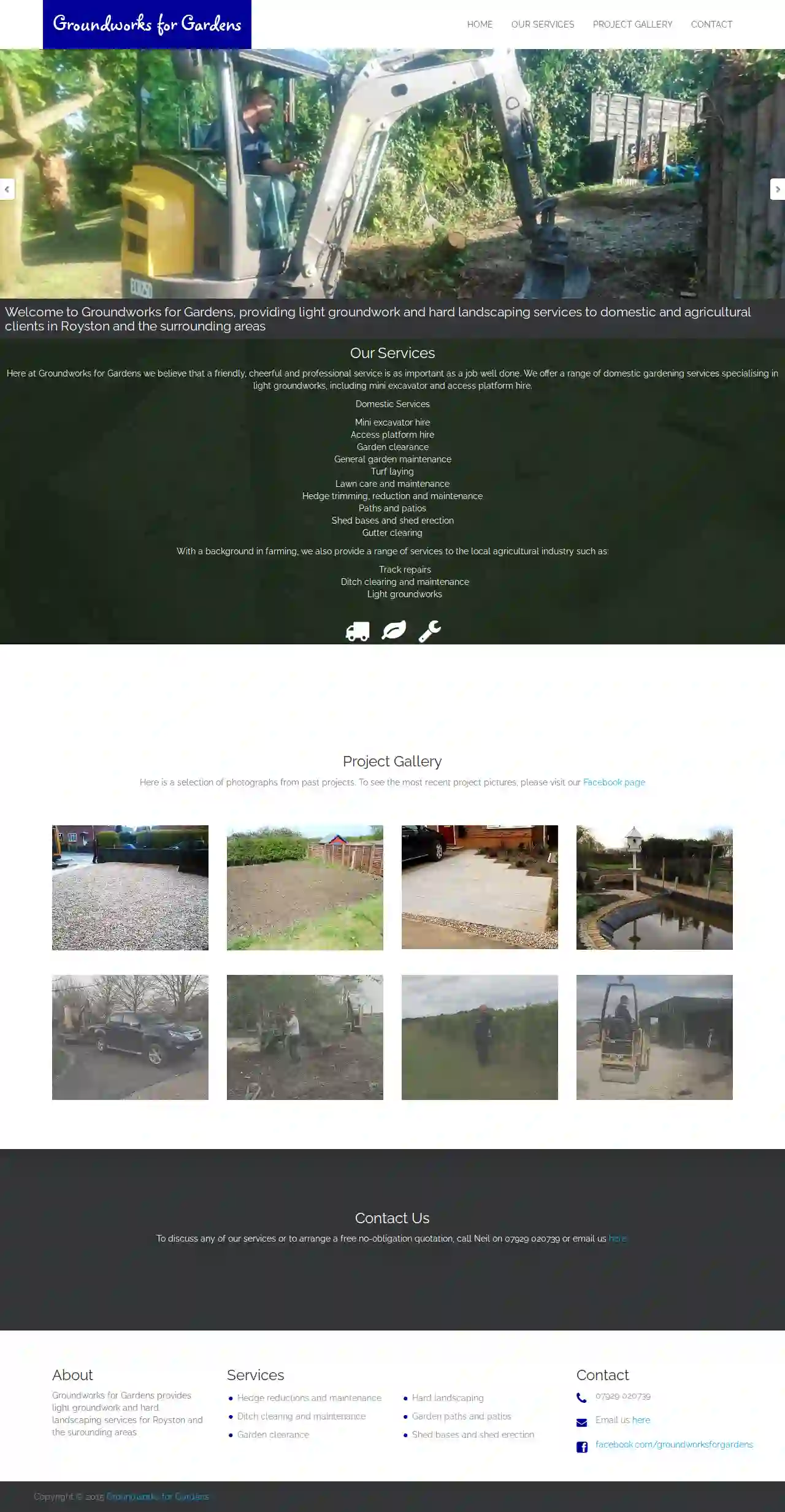Excavation Contractors Wilstead
Top 10 Excavation Companies in Wilstead
Receive multiple Excavation Contractors quotes for your project today! Compare profiles, reviews, accreditations, portfolio, etc... and choose the best offer.

Broad Enterprises
52 reviews183 OW Road, Bangor, 18013, GBAbout Broad Excavating Founded in 1999, Broad Excavating is a true excavating company in Eastern PA. Broad Excavating has earned a reputation for being the area's leading excavating company. Our reputation continues to grow because we truly care for our customers. Whether you are in the Lehigh Valley, Slate Belt or North of the Pocono's, give us a call at 610-588-6941 to see how we can help you! Chances are - “if it’s in the dirt, we do it”. If Broad does it, the job will be done right. Broad Excavating is licensed and fully insured. PA contractor license # PA036341 Since 1999 Broad Excavating has been offering both residential and commercial excavating services in the Slate Belt, Lehigh Valley and Poconos regions. Owner Dave Broad's background in engineering and bio-mechanics combined with hard work has earned Broad Excavating a reputation as a leading excavating company in the area. We truly care for our customers on each project we do, making sure that you are comfortable and the job site is well cared for. We do not leave garbage behind or throw trash on the ground, we care and tend for your job as if we were working on our own project. If you're ever unsure and have a question, just ask! Areas We Service: Slate Belt, Lehigh Valley and Pocono’s region as well as Monroe County, Northampton, Berks County, Bucks, Carbon.
- Services
- Why Us?
- Testimonials
- Gallery
Get Quote
Lee Construction Builders LTD
571 reviews2 Benstede, Stevenage, SG2 8JL, GBLee Construction Builders LTD Your local, Reliable, trusted Stevenage Builder All our team are fully qualified and experienced tradesmen that have seen and dealt with every building challenge possible. We have a track record of happy satisfied customers as we provide a friendly, professional service, and are always respectful of our customers, understanding that our workplace is your home. Lee Construction Builders LTD are your local Builders in Stevenage. We offer free quotations and can build your project for a fixed price. We Specialise in Home extensions, Brickwork, Structural alterations / Refurbishment works, Supporting wall removal / Load bearing wall removal, Chimney removal, Roofing & roof repairs. We offer free quotes and all work is guaranteed. Also the price we quote you is the price you pay. We do not believe in pricing cheap to win jobs then adding on extras as we go. We encourage all new customers to come and visit us on our current projects, that way you’ll get to see the quality of our work and even meet our customers to get some real-time feedback. We're always building somewhere in or around Stevenage area so give us a call today. As local Builders in Stevenage, Hertfordshire we work closely with local architects and structural engineers so we're able to help you from planning to completion or alternatively we can quote and build to your existing plans. Although we are Stevenage based Builders we do cover other areas in Hertfordshire. Here's some of the places we've worked in over the years. Stevenage, Knebworth, Welwyn, Aston, Ware, Tewin, Datchworth, Hitchin, Letchworth, Hertford & Welwyn Garden City
- Services
- Why Us?
- Testimonials
- Gallery
Get Quote
A Prendi Construction LTD
20 Brunel Drive, NORTHAMPTON, NN5 4AF, GBAbout A Prendi Construction LTD A Prendi Construction LTD has achieved a remarkable reputation with over 25 years of experience in the construction industry. For more than two and a half decades, our unwavering commitment to professionalism and core values has made A Prendi Construction LTD the ideal building contractor for numerous domestic and commercial partners. Our success stems from a steadfast commitment to realizing the client's vision and fostering a culture of balance, integrity, leadership, and loyalty. At A Prendi Construction LTD, we transform the construction experience by creating an environment that encourages collaboration and active engagement from the entire project team. We are proud of the dedication, skill, and integrity of each of our employees, and their unique contributions in building our high-performance teams. Our workplace attracts and retains the best talent in every field, ensuring we consistently deliver exceptional results. Our Promise Professionalism Excellence Timeliness
- Services
- Why Us?
- Testimonials
- Gallery
Get Quote
Specialist Plant Associates Ltd
51 reviewsAirfield Road, Hinwick, Wellingborough, Northants, NN29 7JQ, GBSpecialist Plant Associates is the leading independent equipment hire and engineering service supplier to the UK for the tunnelling, construction and civil engineering industries. We offer our customers unrivalled support and guidance with their equipment as well as next day delivery on many of our products. Our main priority is giving our customers a quality service that meets their needs, which is why all of our equipment is robust, safe and built to last! We operate a range of equipment, including one of the UK's largest substantial fleet of ventilation fans and our own in-house designed air powered grouting equipment, which offers simplicity with rugged reliability for the harshest of conditions. Not quite what you are looking for? We have the ability to provide you with adapted equipment to suit your needs or a complete new design. For many years we have been manufacturing and designing our own products and engineering solutions to meet customer demands. With years of experience in construction ventilation, why not let us design your ventilation system for you. Our engineers will ensure full compliance with all ventilation requirements and regulations for Air Quality No/No2 and dust. Our robust temporary ventilation systems suit any application.
- Services
- Why Us?
- Accreditations
- Gallery
Get Quote
Applebee Carpentry & Joinery ltd
4.36 reviews41 - 43 Temple Street, 41 - 43 Temple Street Rugby, Rugby, CV21 3TB, GBWelcome to Applebee Carpentry & Joinery, where craftsmanship meets dedication. Established in 2014, our journey began with a foundation in Carpentry & Joinery, followed by invaluable experience alongside one of London's seasoned Master Carpenters. With over 15 years of honing skills, knowledge, and expertise, we've emerged as true experts in the field. Committed to quality over competition, we prioritize creating timeless pieces through trustworthy techniques. As a British-born company, we specialize in designing and crafting woodwork for your entire home. Additionally, we excel in commercial refurbishments, bringing the same dedication and expertise to transform commercial spaces. Fuelled by a passion for new projects, we excel in bringing clients' visions to life. Embracing the ethos of timelessness, our meticulous craftsmanship ensures that the pieces endure not just years, but generations. Welcome to a world where your dreams become enduring realities, whether in residential or commercial settings. Our Company As a multi-disciplined company with in-house capabilities, ACJ sets the standard for excellence in the industry. Our commitment to being the best drives everything we do, from project conception to completion. Applebee carpentry & joinery is dedicated to being the best in the industry by leveraging our multi-disciplined approach, in-house capabilities, commitment to continuous improvement, client-centric approach, innovation and creativity, and unwavering commitment to excellence. When you choose ACJ, you can trust that you're partnering with a team that will go above and beyond to deliver outstanding results. We offer flexibility in how we engage with our clients, whether it's as a main contractor or on a subcontractor basis. Our ability to adapt to various project roles ensures that we can meet the unique needs and preferences of each client.
- Services
- Why Us?
- Gallery
Get Quote
Jaysim Groundwork & Building Services
51 reviews26 Handcross Way, Higham Ferrers, Northamptonshire, NN10 8AE, GBWelcome to Jaysim Groundwork & Building Services Looking for a reputable builder in Northamptonshire? Seeking a contractor you can trust? Need an expert with over 20 years of experience in block paving paths, driveways, and patios? If so, call Jaysim Groundwork & Building Services for all your construction needs. We can extend your home and add value to your property with a professional house extension. Block paving is one of our specialties, and we can transform your garden with new patios, paths, and driveways. Based in Higham Ferrers, Northamptonshire, we are willing to travel and meet all individual needs. Free quotations are available with full attention to assist you in selecting the right works for your property. We can handle any fencing or drainage jobs you need completed. Interior and exterior tiling can be easily undertaken. We are a Northamptonshire-based family-run business with over 20 years of experience. We pride ourselves on our reputation as professional and reliable builders. So remember, when it comes to block paving patios, paths, and driveways, nobody does it better than Jaysim builders. Unlike many others, we are fully insured and registered members of Fair Trades, ensuring quality of work and peace of mind. Click here to see our registration. We also receive many letters of recommendation from satisfied customers, which, along with any other official documentation, can be viewed at your request. > Click here to view a couple of our letters of recommendation For any further information, please don't hesitate to contact us.
- Services
- Why Us?
- Gallery
Get Quote
Groundworks for gardens
56 reviewsHertford, GBWelcome to Groundworks for Gardens Groundworks for Gardens provides light groundwork and hard landscaping services for Royston and the surrounding areas. We believe that a friendly, cheerful and professional service is as important as a job well done. We offer a range of domestic gardening services specialising in light groundworks, including mini excavator and access platform hire. With a background in farming, we also provide a range of services to the local agricultural industry such as track repairs, ditch clearing and maintenance, and light groundworks.
- Services
- Why Us?
- Gallery
Get Quote
CoDe Construction Ltd
511 reviews14 Park Lane, Paulerspury, NN12 7NF, GBWHO WE ARE Welcome to CoDe Construction Ltd, building contractors in Northamptonshire. With more than 20 years’ experience in a comprehensive and diverse array of construction disciplines, we are able to provide the service you need no matter how big or small the project. This includes: Structural alterations and works Redevelopment Infrastructure Ground/Road works House builds General construction and extension works Internal finishing WHAT OUR CUSTOMERS SAY... "In July 2020 Chris and his team did some pointing work on our property. We are over the moon with the results! The stonework has been transformed! The workmen were experts at their job and the site was left in immaculate condition both during and after completion. A great company to deal with, professional staff with a professional attitude - 5 stars all round and will definitely be using again." Alison, WhittleburyJuly 2020 "I have worked with CoDe on numerous property projects and have always found Chris and his staff very helpful, informative, polite and are reliable with regards to timescales and completing jobs on time and within the agreed budget. They always strive to be accommodating and nothing is too much trouble for them. A project placed with CoDe is a project in safe hands." Natasha, Northampton Roman Catholic Diocesan TrustNov 2021 “I was really happy with the work and professionalism from the whole Code Construction team from start to finish. The care and attention paid by Chris to the customer experience throughout was second to none. In particular, the communication with both my neighbours and I was really appreciated. I felt all of the team made extra effort to ensure the experience was first class and would highly recommend the team.” Steve, SilverstoneAug 2020 OUR SERVICES Some of the building services we can provide: Small and medium works and projects Renovations and listed building works Commercial works House building (we specialise in self-builds) Groundworks/infrastructure and septic tanks Concrete work Structural alterations and reconfiguration Extensions – both residential and commercial Insurance works Hard landscaping Stonework/brickwork and repointing Excavator/skip loader hire and operation General construction and home improvements
- Services
- Why Us?
- Testimonials
- Gallery
Get Quote
Tim Fisher Enterprises Inc
Tim Fisher Enterprises Inc, New Tripoli, 18066, GBTim Fisher Enterprises Inc: Your Trusted Excavating Partner in New Tripoli, PA When it comes to excavation services in New Tripoli, PA, Tim Fisher Enterprises Inc stands out as a reliable and experienced choice. We understand that homeowners and landowners often require professional excavating services for various reasons, and finding a trustworthy contractor can be challenging. That's where we come in. We're dedicated to providing top-notch excavating services, ensuring your projects are completed efficiently and to the highest standards. Our team at Tim Fisher Enterprises Inc is equipped with modern heavy equipment and utilizes state-of-the-art machinery. We adhere to strict safety regulations and protocols, ensuring every excavating service is performed promptly and efficiently. Whether you're laying the foundation for your dream home or transforming your backyard into an oasis, we're the experts to call. We handle a wide range of projects, from underground waterline restoration and pre-construction excavation to commercial land work. Our commitment to quality and customer satisfaction is unwavering. We take pride in our expertise and workmanship, ensuring you receive the best possible results for your excavation needs. Don't hesitate to contact us for a free estimate. We're here to answer your questions and provide the expert guidance you need to make informed decisions about your excavation project. Let Tim Fisher Enterprises Inc be your trusted partner in New Tripoli, PA, for all your excavating needs.
- Services
- Why Us?
- Testimonials
- Gallery
Get Quote
AJS Contracting
Brakes Farm, Thornborough Road, Brakes Farm Thornborough Road Nash, Milton Keynes, MK17 0HN, GBEstablished in 2001, AJS Contracting is a family-run business with a solid reputation for providing a wide range of specialized services. We offer everything from security fencing and drainage to block paving, excavation, and groundworks in Milton Keynes, Bedford, and the surrounding areas of Aylesbury, Leighton Buzzard, and Buckinghamshire. We take a professional approach to all our projects, using our own, professionally trained and supervised groundwork contractors. We can repair and install a range of groundworks, including new roads, car parks, and tarmac surfacing, all on budget and at a time that suits you. We offer a comprehensive range of groundwork solutions and services, provided to both domestic and commercial customers at competitive prices. Over the past few years, AJS Contracting has built a strong reputation for customer care, swift response services, and no-quibble aftercare service, making us a reputable and reliable company, no matter how large or small the job is. We are council-approved contractors serving our local areas of Milton Keynes, Bedford, as well as those further afield within Buckinghamshire and Bedfordshire. We offer free quotations, help, and professional advice, keeping you informed on the project development from the start to the very end!
- Services
- Why Us?
- Gallery
Get Quote
Over 13,059+ Excavation Businesses onboarded
Our excavation contractors operate in Wilstead & surroundings!
ExcavationHQ has curated and vetted the Best Excavation Contractors in Wilstead. Find the most reliable contractor today.
Frequently Asked Questions About Excavation Contractors
- Project Size and Scope: Larger, more complex excavations naturally take longer.
- Soil Conditions: Rocky or challenging soil types can slow down progress.
- Site Accessibility: Limited access might require more time for maneuvering equipment and hauling materials.
- Weather: Inclement weather can cause delays.
- Permitting and Inspections: Waiting for permits or inspections can extend the timeline.
- Topsoil Removal: Stripping the fertile topsoil layer from a site, often preserving it for landscaping.
- Trench Excavation: Digging long, narrow trenches for utilities (pipes, cables) or foundations.
- Basement Excavation: Removing earth to create a space for a basement beneath a structure.
- Pool Excavation: Digging a precise hole for installing a swimming pool.
- Roadway Excavation: Removing earth and preparing the ground for road construction.
- Demolition Excavation: Clearing debris and preparing the site after demolition.
- Channel Excavation: Creating channels for drainage or irrigation.
- Project Size and Scope: The larger and more complex the excavation, the higher the cost.
- Soil Type: Different soil types require different equipment and techniques, impacting costs. Rocky or clay-rich soil can be more expensive to excavate than loose soil.
- Accessibility: Difficult-to-access sites might require specialized equipment or additional labor, increasing expenses.
- Disposal Costs: Hauling away excavated material (soil, rocks, etc.) to disposal sites incurs additional fees.
- Permits and Inspections: Depending on local regulations, permits and inspections might be required, adding to the overall cost.
- Utility Locates: Contact your utility companies to mark the locations of underground lines before excavation begins. This is usually a free service.
- Hand Digging: Excavate carefully by hand near marked utility lines to avoid damage.
- Potholing: Digging small test holes to expose and verify utility depths and locations.
- Safe Distances: Maintaining a safe distance between excavation equipment and marked utility lines.
- Vacuum Excavation: Using vacuum excavation techniques to expose utilities without digging, reducing the risk of damage.
How long does an excavation project take?
What are the different types of excavation?
How much does excavation cost?
How do you protect utilities during excavation?
How long does an excavation project take?
- Project Size and Scope: Larger, more complex excavations naturally take longer.
- Soil Conditions: Rocky or challenging soil types can slow down progress.
- Site Accessibility: Limited access might require more time for maneuvering equipment and hauling materials.
- Weather: Inclement weather can cause delays.
- Permitting and Inspections: Waiting for permits or inspections can extend the timeline.
What are the different types of excavation?
- Topsoil Removal: Stripping the fertile topsoil layer from a site, often preserving it for landscaping.
- Trench Excavation: Digging long, narrow trenches for utilities (pipes, cables) or foundations.
- Basement Excavation: Removing earth to create a space for a basement beneath a structure.
- Pool Excavation: Digging a precise hole for installing a swimming pool.
- Roadway Excavation: Removing earth and preparing the ground for road construction.
- Demolition Excavation: Clearing debris and preparing the site after demolition.
- Channel Excavation: Creating channels for drainage or irrigation.
How much does excavation cost?
- Project Size and Scope: The larger and more complex the excavation, the higher the cost.
- Soil Type: Different soil types require different equipment and techniques, impacting costs. Rocky or clay-rich soil can be more expensive to excavate than loose soil.
- Accessibility: Difficult-to-access sites might require specialized equipment or additional labor, increasing expenses.
- Disposal Costs: Hauling away excavated material (soil, rocks, etc.) to disposal sites incurs additional fees.
- Permits and Inspections: Depending on local regulations, permits and inspections might be required, adding to the overall cost.
How do you protect utilities during excavation?
- Utility Locates: Contact your utility companies to mark the locations of underground lines before excavation begins. This is usually a free service.
- Hand Digging: Excavate carefully by hand near marked utility lines to avoid damage.
- Potholing: Digging small test holes to expose and verify utility depths and locations.
- Safe Distances: Maintaining a safe distance between excavation equipment and marked utility lines.
- Vacuum Excavation: Using vacuum excavation techniques to expose utilities without digging, reducing the risk of damage.